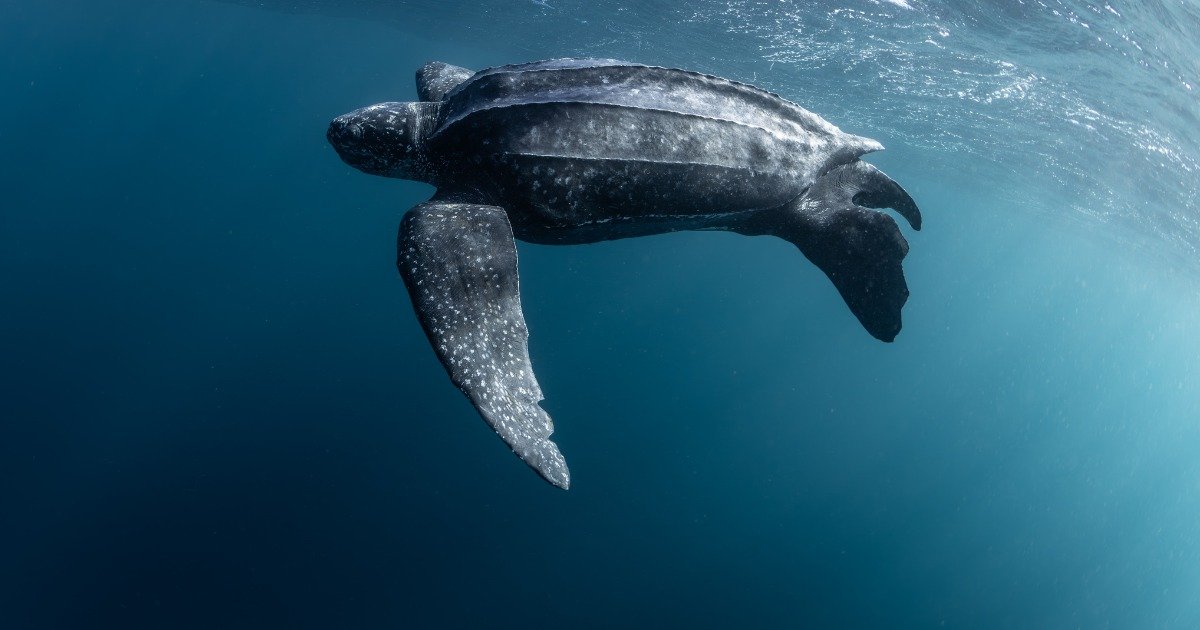Leatherback Sea Turtles are the last surviving members of the family Dermochelyidae, an ancient lineage that dates back 100-150 million years. These turtles are the largest of their kind, weighing up to 900 kg and boasting a shell length of up to 2 meters. Unlike other sea turtles, Leatherbacks don’t have hard shells. Instead, their shells are covered with a leathery, slightly flexible, fibrous tissue overlaying interlocking bony plates. The bluish-black shell has seven ridges running from front to back and tapers to a blunt point, creating a streamlined, teardrop shape. Their front flippers are notably long, often half the length of their shell, and lack claws, which differentiates them from other sea turtles. Additionally, their shells, necks, heads, and front flippers are frequently marked with white or bluish-white blotches. Adult Leatherbacks have a distinct pink patch on their heads, unique in size, shape, color, and pattern. These turtles primarily feed on gelatinous prey like jellyfish and salps. They lack the chewing plates found in other sea turtles, instead having sharp-edged jaws and backward-pointing spines in their mouths and esophagi to help retain and swallow their soft-bodied prey.
Pacific Leatherbacks have two main nesting populations: one in the Eastern Pacific (Mexico and Costa Rica) and one in the Western Pacific (Malaysia, Solomon Islands, Papua New Guinea, and Indonesia). The Leatherbacks found in Canadian Pacific waters are part of the Western Pacific population, migrating up to 15,000 km from Indo-Pacific nesting beaches to forage on jellyfish and other gelatinous prey. Sightings in Canadian Pacific waters are rare, with only 126 unique sightings reported in British Columbia from 1931 to 2009. This species’ pelagic nature and the difficulty of spotting them from a distance lead to many uncertainties regarding their habitat use off the coast of British Columbia. The Pacific Leatherback Sea Turtle population has declined by up to 95% in the last 50 years and is currently Endangered.
Females lay about 100 eggs per clutch, several times during a nesting season, typically at 8-12 day intervals. They return to the nesting site every 2-3 years. After approximately two months, hatchlings emerge from the nest and make their way to the ocean, usually at night to avoid predation and reduce the risk of desiccation.
On Indo-Pacific nesting beaches, Leatherback eggs face predation from mammals like pigs and feral dogs. Humans also pose a threat, as Leatherback eggs are considered a delicacy in some countries. Development near nesting beaches negatively impacts hatchlings, as bright lights disorient them, causing exhaustion, dehydration, or predation as they struggle to find the ocean. Despite laying about 100 eggs per clutch and nesting up to 10 times a season, only a few hatchlings survive to adulthood and breed. Leatherback Sea Turtles face numerous human-induced threats in the marine environment. They are often accidentally caught in fisheries, and entanglement in fishing gear is common. While many fishers release trapped Leatherbacks, some turtles drown or sustain fatal injuries before help arrives. Leatherbacks can also get tangled in discarded debris, collide with vessels, or mistake floating plastic bags and debris for jellyfish prey, leading to obstruction of the digestive system and eventual death from starvation.










